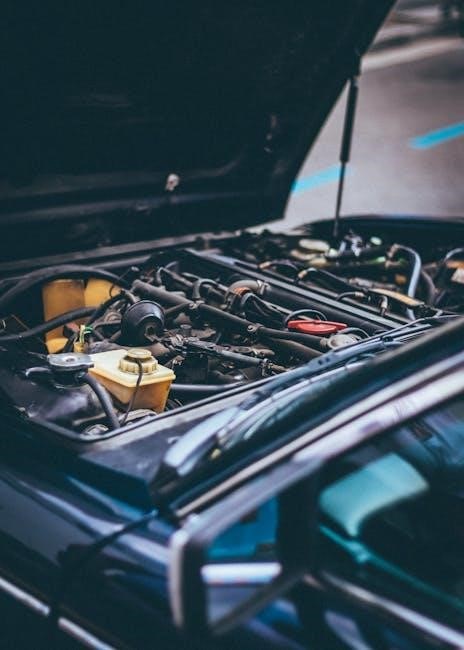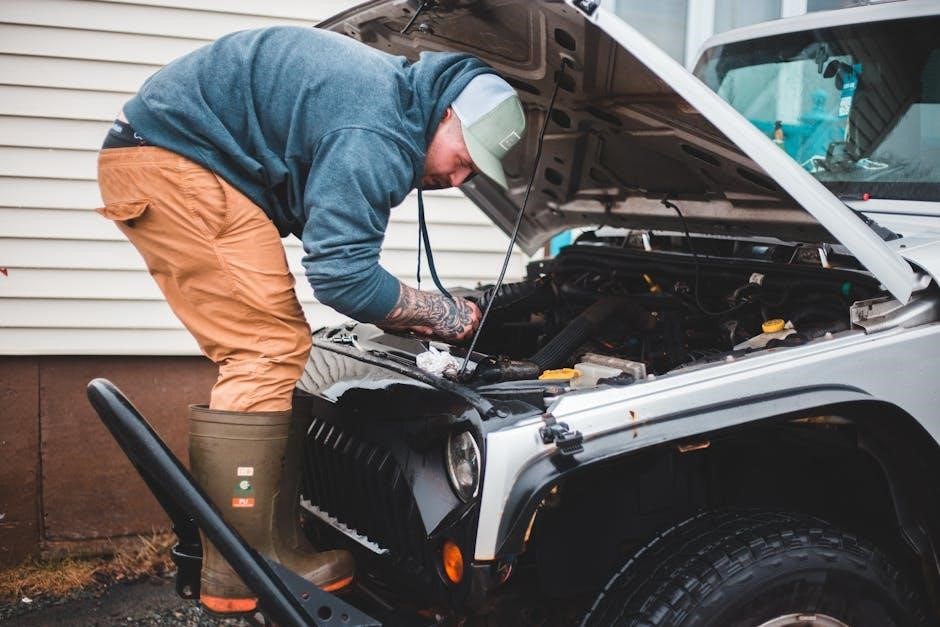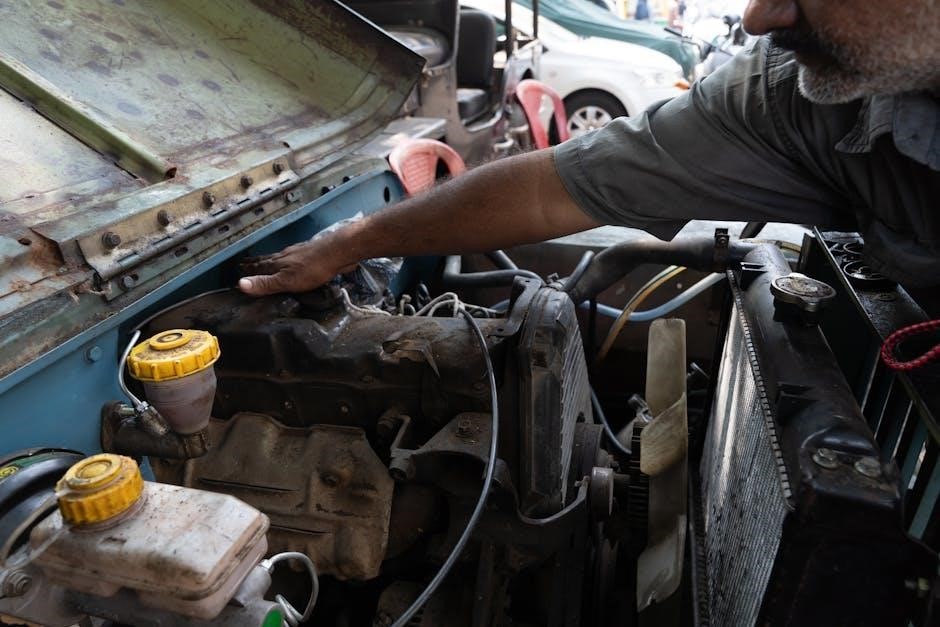The 2016 Jeep JKU engine bay diagram PDF provides a detailed visual guide for understanding the layout and components of the JKU’s engine compartment․ It is an essential resource for DIY enthusiasts, mechanics, and Jeep owners looking to perform repairs, modifications, or routine maintenance․ This document highlights the 3․6-liter Pentastar V6 engine, cooling systems, electrical components, and fuel systems, making it indispensable for troubleshooting and upgrades․ Available through official Jeep resources, forums, and third-party manuals, the diagram ensures accuracy and clarity for any project․
Overview of the Engine Bay Diagram
The 2016 Jeep JKU engine bay diagram offers a comprehensive visual representation of the engine compartment, detailing the layout of key components such as the 3․6-liter Pentastar V6 engine, cooling system, electrical wiring, and fuel system․ This diagram serves as a critical reference for identifying parts, troubleshooting issues, and performing modifications․ It provides clear labels and annotations, making it easier for users to understand the interconnected systems․ Whether for routine maintenance or complex repairs, the diagram is an indispensable tool for anyone working on their JKU․
Importance of the Diagram for Repairs and Modifications
The 2016 Jeep JKU engine bay diagram is a vital tool for repairs and modifications, providing a clear visual guide to the engine compartment’s layout․ It helps identify components, diagnose issues, and plan upgrades accurately․ By understanding the diagram, users can avoid costly mistakes and ensure safety during DIY projects․ Whether replacing parts or optimizing performance, the diagram simplifies complex tasks, making it an essential resource for both novices and experienced enthusiasts working on their Jeep JKU․
History of the Jeep Wrangler JKU Model
The Jeep Wrangler JKU (Unlimited) was introduced in 2007 as part of the JK generation, marking a significant evolution in off-road capability and modern design․ Known for its ruggedness and versatility, the JKU quickly became popular among enthusiasts․ The 2016 model featured the 3;6-liter Pentastar V6 engine, enhancing performance and efficiency․ Over the years, the JKU has maintained its reputation as a reliable and customizable vehicle, making it a favorite for both daily drivers and adventure-seekers․ Its enduring legacy underscores Jeep’s commitment to innovation and off-road excellence․

Key Components of the 2016 Jeep JKU Engine Bay
The 2016 Jeep JKU engine bay features the 3․6-liter Pentastar V6 engine, a robust cooling system, advanced electrical components, and a reliable fuel system․ These elements work together to ensure optimal performance and durability, making the JKU a powerhouse for both on-road and off-road adventures․
3․6-Liter Pentastar V6 Engine Overview
The 3․6-liter Pentastar V6 engine in the 2016 Jeep JKU delivers exceptional power and efficiency․ This 60-degree V-type, liquid-cooled engine produces impressive horsepower and torque, making it ideal for both on-road driving and off-road adventures․ Known for its reliability and smooth operation, the Pentastar V6 features advanced technology, including variable valve timing and a high-flow intake system․ It is paired with a responsive automatic or manual transmission, ensuring a balanced blend of performance and fuel efficiency․ This engine is a cornerstone of the JKU’s capability and durability․
Cooling System Layout and Components
The cooling system in the 2016 Jeep JKU is designed to maintain optimal engine temperature, ensuring reliability in various driving conditions․ Key components include the radiator, coolant hoses, water pump, and thermostat․ The radiator is centrally located in the engine bay, with hoses connecting it to the engine block․ The water pump circulates coolant through the system, while the thermostat regulates flow based on temperature․ The diagram provides a clear visual layout, helping users identify and service these parts efficiently for proper cooling system function and longevity․

Electrical Components and Wiring Diagrams
The 2016 Jeep JKU engine bay diagram PDF includes detailed wiring diagrams and electrical component layouts․ These diagrams are crucial for understanding the vehicle’s electrical system, including the battery, alternator, fuse boxes, and wiring harnesses․ They provide clear visuals of circuit connections, making it easier to diagnose and repair electrical issues․ The diagrams also highlight essential components like sensors, relays, and connectors, ensuring accurate troubleshooting and modifications․ This resource is invaluable for enthusiasts and mechanics working on electrical system maintenance or upgrades․
Fuel System and Related Parts
The 2016 Jeep JKU engine bay diagram PDF details the fuel system, including fuel lines, injectors, and the fuel pump․ It illustrates the layout of the fuel tank, fuel filter, and routing of fuel lines to the engine․ This diagram is essential for identifying components during repairs or upgrades․ It also highlights connections to the 3․6-liter Pentastar V6 engine, ensuring proper fuel flow and pressure․ The visual guide aids in diagnosing fuel-related issues and simplifies modifications, making it a vital tool for maintaining the vehicle’s performance and reliability․

Locating the Engine Bay Diagram PDF

The 2016 Jeep JKU engine bay diagram PDF can be sourced from official Jeep websites, forums, and third-party repair guides, ensuring easy access for DIY projects and repairs․
Official Jeep Websites and Resources
Official Jeep websites provide authentic access to the 2016 JKU engine bay diagram PDF, ensuring accuracy and reliability for repairs and modifications․ These resources are tailored for professionals and DIY enthusiasts, offering detailed diagrams and service manuals specific to the 2016 Jeep Wrangler Unlimited․ The official portal often includes model-specific guides, including the 3․6-liter V6 engine layout, cooling systems, and electrical components․ While some resources may require purchase, they guarantee precise information for troubleshooting and upgrades, making them indispensable for maintaining or enhancing your JKU․
Jeep Forums and Community Contributions
Jeep forums and community contributions are invaluable for accessing the 2016 JKU engine bay diagram PDF․ Enthusiast-driven platforms like Jeep Wrangler JKU forums often share DIY guides, wiring diagrams, and detailed engine layouts․ Members frequently post scanned or downloadable resources, including parts lists and repair tips․ These communities foster collaboration, with users sharing their experiences and solutions․ While some resources may require forum membership or purchase, they offer a wealth of knowledge for troubleshooting and modifications․ The collective expertise of Jeep enthusiasts ensures a comprehensive understanding of the JKU engine bay․
Third-Party Manuals and Repair Guides
Third-party manuals and repair guides offer comprehensive resources for the 2016 Jeep JKU engine bay diagram PDF․ These manuals, often available as downloadable PDFs, include detailed wiring diagrams, parts lists, and step-by-step repair instructions․ They are particularly useful for DIY enthusiasts and mechanics, providing in-depth insights into the engine bay layout․ Many third-party guides are tailored to specific Jeep models, ensuring accuracy and relevance․ Some popular options include factory service manuals and independent repair guides, which cover everything from routine maintenance to complex modifications․ These resources are invaluable for troubleshooting and upgrades․

Understanding the Engine Bay Diagram
The 2016 Jeep JKU engine bay diagram PDF provides a clear visual representation of the engine compartment, highlighting key components and their relationships․ It aids in identifying parts, understanding electrical systems, and interpreting symbols for effective repairs and modifications․ This resource is essential for DIY enthusiasts and professionals alike, ensuring precise and efficient work on the vehicle’s engine․
How to Read and Interpret the Diagram
To effectively read the 2016 Jeep JKU engine bay diagram, start by identifying major components like the 3․6-liter Pentastar V6 engine, cooling system, and electrical parts․ Use the legend to understand symbols, such as color-coded wires or fluid lines․ Trace connections between parts to grasp system interactions․ Pay attention to labels and arrows, which indicate flow directions or specific functions․ For unfamiliar symbols, cross-reference them with the diagram’s key․ This method ensures precise identification of components and their roles, aiding in repairs, modifications, or routine maintenance․ Regular practice enhances understanding and application․
Common Symbols and Notations Used
The 2016 Jeep JKU engine bay diagram uses standardized symbols to represent components․ Circles often denote connectors, while rectangles may indicate electrical components․ Color-coded lines differentiate systems: green for coolant, red for battery positive, and yellow for signal wires․ Arrows show flow direction, such as coolant or fuel movement․ Abbreviations like “ECU” (Engine Control Unit) are common․ Cross-reference these symbols with the diagram’s legend for clarity․ Understanding these notations ensures accurate identification of parts and connections, simplifying repairs and modifications․ Familiarity with these symbols enhances overall comprehension of the engine bay layout and functionality․
Disassembly and Reassembly Procedures
Disassembling the engine bay requires careful planning and adherence to the 2016 Jeep JKU diagram․ Start by disconnecting the battery and draining fluids to prevent damage or leaks․ Remove components systematically, starting with exterior parts like the serpentine belt and air intake․ Use the diagram to identify fasteners and connectors․ Label and organize parts to ensure proper reassembly․ Reattach components in reverse order, tightening bolts to specified torque values․ Referencing the diagram ensures accuracy and prevents misconnection of critical systems like cooling or fuel lines․ This methodical approach minimizes errors and ensures functionality after reassembly․

Troubleshooting with the Engine Bay Diagram
The 2016 Jeep JKU engine bay diagram aids in identifying issues by providing a clear visual of components․ Use it to locate faulty parts, trace connections, and understand system interactions․ Referencing the diagram helps diagnose common problems like cooling system leaks or electrical malfunctions․ It streamlines troubleshooting, ensuring accurate repairs and minimizing downtime․ This visual guide is essential for resolving engine-related issues efficiently and effectively․
Common Issues Identified Using the Diagram
The 2016 Jeep JKU engine bay diagram helps identify common issues like coolant leaks, faulty sensors, and wiring harness problems․ It visually highlights areas prone to malfunction, such as the 3․6-liter V6 engine’s water pump or electrical connectors․ Users can pinpoint issues like a malfunctioning fuel pump or cracked hoses by cross-referencing symptoms with the diagram․ This tool is invaluable for diagnosing problems like engine overheating or poor performance, ensuring repairs are targeted and efficient․ It simplifies troubleshooting by providing a clear, detailed layout of all engine bay components․
Diagnostic Techniques for Engine Components
The 2016 Jeep JKU engine bay diagram aids in diagnosing issues by providing a clear layout of components․ Techniques include visual inspections for leaks or damage, checking sensors for proper connectivity, and testing electrical circuits using the wiring diagrams․ The diagram helps identify faulty parts like the coolant temperature sensor or fuel injectors by pinpointing their locations․ It also assists in tracing wiring harness connections to resolve electrical faults․ By referencing the diagram, users can perform benchmark tests on the 3․6-liter V6 engine and related systems, ensuring accurate and efficient diagnostics․
DIY Projects and Modifications
The 2016 Jeep JKU engine bay diagram PDF is a vital tool for DIY projects and modifications, offering a detailed overview of the engine compartment․ It helps enthusiasts identify components for upgrades like engine swaps or performance enhancements․ Common modifications include upgrading air intake systems, improving cooling efficiency, or installing aftermarket fuel injectors․ The diagram provides a clear layout, enabling precise planning and execution of upgrades․ Additionally, it serves as a guide for installing accessories like winches or suspension lifts, ensuring compatibility and proper integration with existing systems․ This resource empowers owners to customize their JKU confidently․

Wiring Diagrams for the 2016 Jeep JKU
The wiring diagrams for the 2016 Jeep JKU provide detailed schematics of the electrical systems, essential for diagnosing and repairing faults․ They outline circuit configurations, connector locations, and wire colors, aiding in troubleshooting and custom modifications․ These diagrams are often included in official service manuals or available through forums and third-party resources, ensuring accurate electrical system understanding and repairs․
Importance of Wiring Diagrams for Repairs
Wiring diagrams are crucial for diagnosing and repairing electrical issues in the 2016 Jeep JKU․ They provide a detailed map of the vehicle’s electrical system, allowing technicians to identify faulty circuits, connectors, and components․ These diagrams help avoid costly mistakes by ensuring accurate repairs․ They also save time by pinpointing the root cause of electrical problems quickly․ For DIY enthusiasts and professionals alike, wiring diagrams are indispensable for maintaining and upgrading the Jeep’s electrical systems, ensuring reliability and performance․ They are often included in official service manuals or available online for easy access․
How to Interpret Wiring Schematics
Interpreting wiring schematics for the 2016 Jeep JKU requires understanding the symbols, colors, and notations used․ Start by locating the legend or key in the diagram, which explains each symbol․ Identify the specific circuit you’re working on, such as the engine or lighting system․ Trace the wiring from the power source through fuses, relays, and connectors to the final component․ Pay attention to ground points and connector locations․ This process helps in diagnosing electrical issues and ensures accurate repairs․ Familiarity with common symbols and notations is essential for effective troubleshooting and modifications․
Common Electrical Faults and Solutions
Common electrical faults in the 2016 Jeep JKU include blown fuses, faulty sensors, and corroded connections․ Use the wiring diagram to trace circuits and identify issues․ Replace blown fuses with the correct amperage rating and clean corroded terminals․ For faulty sensors, consult the diagram to locate and test the component․ Addressing these issues promptly prevents further damage․ Always disconnect the battery before working on electrical systems and refer to the wiring schematic for accurate repairs; If unsure, consult a professional or the official service manual for guidance․

Safety Precautions When Working with the Engine Bay
Disconnect the battery, wear protective gear, ensure good ventilation, and avoid hot components․ Use proper tools and ensure the vehicle is stable before starting work for your safety․
Essential Safety Gear and Tools
When working with the 2016 Jeep JKU engine bay, essential safety gear includes gloves, safety glasses, and a face mask․ A multimeter, wrenches, pliers, and screwdrivers are vital tools․ Ensure you have a jack and jack stands for lifting the vehicle safely․ Proper tools prevent damage to components and ensure accurate repairs․ Always disconnect the battery to avoid electrical shocks․ Keep a fire extinguisher nearby and work in a well-ventilated area․ These precautions and tools are crucial for protecting yourself and maintaining your Jeep effectively․
Proper Disconnection of Battery and Fuel Lines
Disconnecting the battery and fuel lines is critical for safety when working on the 2016 Jeep JKU engine bay․ Start by locating the negative terminal of the battery and detaching it to prevent electrical shocks․ For fuel lines, relieve pressure by opening the fuel cap or using a pressure relief tool․ Use appropriate wrenches or line tools to disconnect fuel lines, ensuring no residual fuel leaks․ Always work in a well-ventilated area and avoid open flames or sparks․ Proper disconnection prevents hazards and protects the vehicle’s systems during repairs or modifications․
Best Practices for Working with Electrical Systems
When working with the 2016 Jeep JKU electrical systems, consult the wiring diagram to identify circuits and components․ Use insulated tools to prevent short circuits and ensure all power sources are disconnected․ Ground yourself to avoid static discharge, which can damage sensitive electronics․ Test components like sensors and relays before reassembly to confirm functionality․ Avoid splicing wires unless necessary, and use OEM-approved connectors for reliability․ Always refer to the diagram for accurate wire colors and connections to maintain system integrity and ensure safe, effective repairs or modifications․
The 2016 Jeep JKU engine bay diagram PDF is an essential resource for repairs, modifications, and troubleshooting, offering clear visuals and detailed information to empower DIY enthusiasts and professionals alike․

The 2016 Jeep JKU engine bay diagram PDF serves as a vital visual guide, simplifying repairs, modifications, and troubleshooting․ It provides a detailed layout of components like the 3․6-liter V6 engine, cooling systems, and electrical wiring, making it indispensable for professionals and DIY enthusiasts alike․ By offering a clear understanding of the engine compartment, this resource empowers users to confidently tackle projects, ensuring accuracy and safety․ Its comprehensive nature makes it an essential tool for maintaining and upgrading the Jeep JKU, enhancing both performance and reliability․
Frequently Asked Questions (FAQs)
Where can I find the 2016 Jeep JKU engine bay diagram PDF? It is available on official Jeep websites, forums, and third-party repair guides․ What does the diagram include? It features detailed layouts of the 3․6-liter V6 engine, cooling systems, and electrical components․ Can I use it for DIY repairs? Yes, it is ideal for troubleshooting, modifications, and routine maintenance․ Are there safety tips included? Yes, it emphasizes proper disconnection of battery and fuel lines․ This resource is essential for anyone working on their Jeep JKU, providing clarity and confidence for engine-related projects․
